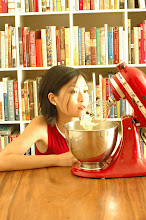Gai Juk, Chicken Congee for the Soul
 Growing up, I was put under the charge of a Cantonese amah for a while. Not a very long while; let's just say having one cook in the kitchen was key to keeping the domestic peace. Her tenure may not have been long-lived, but her legacy prevailed in the humble, honest, heartening form of juk (or zhou in Mandarin), the soupy rice porridge/gruel also commonly known as congee.
Growing up, I was put under the charge of a Cantonese amah for a while. Not a very long while; let's just say having one cook in the kitchen was key to keeping the domestic peace. Her tenure may not have been long-lived, but her legacy prevailed in the humble, honest, heartening form of juk (or zhou in Mandarin), the soupy rice porridge/gruel also commonly known as congee.There are many regional recipes for the making of congee; some are rice-based, some not, and yet some use a mixture of rice and other grains. Some start with raw rice, others specify the use of leftover cooked rice. The style in which our amah cheh made her congee, the style I was weaned on and identify with and crave, was classically southern Chinese. A mixture of two types of rice (regular long-grained white plus glutinous) slowly, slowly simmered in a vast volume of water until transformed into velvety, unctuous comfort food. No mere sustenance, this, but the penultimate restorative, a homebrewed cureall, a magical unguent to cosset the body and salve the soul. Be it the nourishment of the very young or the very old, or the nursing back to wellness of the ill, or the simple soothing of frayed nerves, there are few things that are entrusted with rising to the occasion like congee, especially if you, like me, are Chinese in ethnicity.
As a student at college half a world away from home, congee became an antidote to the occasional bout of homesickness. Till this day, whenever I've had an especially long or trying day, there is nothing I long to eat more. W had been under the weather recently, so we'd been tucking into congee suppers - gai juk (chicken congee), pei dan sau yuk juk (preserved egg and pork congee), or yu juk (fish congee) - pretty often the last couple of weeks.
Not everyone digs pei dan. And not everyone has access to super duper fresh fish, an absolute non-negotiable for yu juk, preferably slaughtered and filleted earlier in the day at the wet market, my personal preference for using in yu juk is either grass carp or snakehead (locally known as toman). So the recipe that follows is for gai juk. Some preliminary notes:
Rice I use a combination of two rices; one for taste, the other for texture, in a two-to-one ratio. First, a fragrant long grain, preferably hom mali. This translates from Thai to "fragrant jasmine", although the aroma (hom) is really redolent of pandan and not jasmine. Mali, the reference to jasmine, is meant to describe the opalescent sheen of the grain rather than the scent. The subtle yet distinctive hom mali perfume makes an important difference to the final flavour of the congee. Second, a glutinous rice (sticky rice), as its high-amylopectin/low-amylose constitutional makeup greatly enhances creaminess.
 Gai Juk (Chicken Congee)
Gai Juk (Chicken Congee)Yields about 4 servings
100 gm Long grain rice
50 gm Glutinous rice
1 Tbsp Toasted white sesame oil
2.5 litres Chicken stock, or water
1 tsp Coarse sea salt, or to taste
Half a small chicken (about 400 to 450 gm)
A slice of young ginger (about 1cm-thick)
Garnishes:
Tong chai (salt-preserved Tianjin cabbage pickle)
Fried shallots
Scallions, finely sliced
Coriander sprigs
Toasted white sesame oil
1. Combine the two rices in a large bowl. Wash and drain three times under water, each time swishing the rice around whilst rubbing the grains between your fingers.
2. Place washed rice in a heavy-bottomed pot with a capacity of about 5 litres. Coat grains with the sesame oil. Add the stock (or water), salt, chicken and ginger.
3. Bring to the boil over high heat. Reduce heat to low and cover. The liquid should simmer at the merest blip; use a heat diffuser/tamer mat if necessary. Cook for 2 hours, stirring occasionally to prevent the rice from sticking to the bottom of the pot and scorching. The rice will have "blossomed" (the grains will have swelled and split). Remove the chicken and set aside. Continue cooking the congee for another 1 hour, stirring occasionally, until it is thick, creamy and almost smooth. Taste; season with more salt to taste if necessary.
4. Meanwhile, once the chicken is cool enough to handle, shred the flesh into medium sized pieces. Discard the skin and bones. Set the chicken shreds aside.
5. When the congee is ready, turn the heat off. Discard the ginger. Heat large soup bowls by pouring boiling water into the bowls then pouring away the water. Ladle the porridge into the heated bowls. Top each serving with chicken shreds, and a pinch each of tong chai, fried shallots, scallions and coriander. Finish with a drizzle of toasted white sesame oil. Serve immediately.


